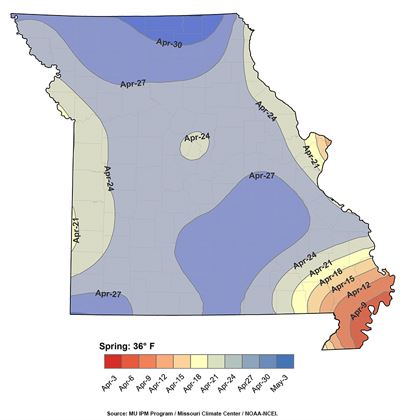MU Extension Guide Lists First, Last Frost Dates By Region
COLUMBIA, MO.
Spring and fall can be anxious times for gardeners. At the beginning of the growing season, you want to start the garden as early as possible, and at the end you hope for a few extra harvest days.
An online resource from University of Missouri Extension makes it easier to predict first and last frost dates for your specific region. The Missouri Frost/Freeze Probabilities Guide is available at http://ipm.missouri.edu/frostfreezeguide.
“These data can be used for making an informed decision when it comes to planting and assessing climatological risk associated with light, moderate and hard freezes in your region during the spring and fall,” said Pat Guinan, climatologist for MU Extension.
The website provides frost/freeze probabilities, tables, maps and dates using data from the National Center for Environmental Information, based on information collected from 1981 through 2010.
Features of the site include median date point maps, which provide the last spring and first fall median frost/freeze dates for various temperature thresholds, Guinan said. There are also median date contour maps and extreme date point maps. All these maps are interactive and printable via high-resolution PDFs.
The site also gives you access to Missouri weather station probability tables for each county. By rolling over the blue dot in each county where data is available, you will see the annual frost/freeze days for the selected station, Guinan said.
The guide provides a general representation of frost/freeze probabilities in your region, Guinan says, but users also need to consider local factors that may affect temperature, such as terrain, elevation and urbanization. “Local anomalies due to microclimates are definitely something to consider when using the guide.”
There’s about 300 miles between the northern and southern boundaries of Missouri, and the state’s growing season can typically run from April to October. Having a guide that separates data by county and regions can help you make informed decisions about when to plant and harvest plants that are sensitive to the cold, Guinan said.
For those who prefer a hard copy of the frost/freeze guide, it can be purchased at http://extension.missouri.edu/p/IPM1033.
Pat Guinan’s list of weather resources is at http://agebb.missouri.edu/weather/wealinks.htm. ∆

A map from MU Extension’s Frost/Freeze Probabilities Guide.
Credit: University of Missouri